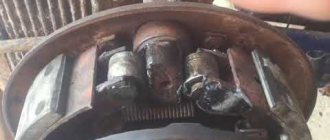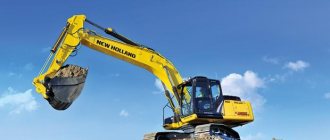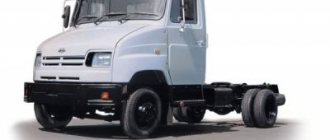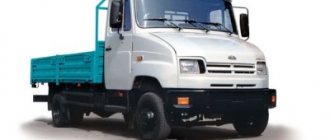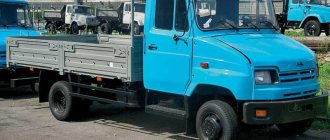ZIL 5301 is a light-duty truck that was assembled at the Likhachev plant from 1995 to 2014. It played an important role in the history of the plant - a promising project designed to revive ZIL in the same way as the low-tonnage GAZelle raised the Gorky Automobile Plant, turned out to be the last. Why did ZIL Bychok, whose technical characteristics look promising, not bring the expected success? The answers are in this article. It is noteworthy that the history of the model began with an error in the name. The index “5301” corresponds to the heavy load class (5 tons). The small-tonnage "Bull" had to have an index starting with three. However, an error occurred during the preparation of documents, which was not immediately noticed. So the incorrect designation stuck. However, the model is popularly known under the nickname “Bull”, given either for the rough contours of the body, or in contrast to the “Gazelle”.
History of creation and description of the model
The beginning of the 1990s was associated with a crisis in the domestic automobile industry. The old ZIL trucks are hopelessly outdated, moreover, the demand for large-tonnage trucks has dropped significantly. If earlier the enterprise “travelled” through military orders and exports to neighboring countries, then in the 90s these markets, if not collapsed, then greatly reduced turnover. At the same time, the demand for compact vehicles for transporting small quantities of cargo was growing.
Trying to keep up with the changing needs of the market, ZIL developed a compact three-ton truck back in 1992. However, for a number of reasons, a suitable engine was not found for the model, and mass production was launched only 4 years later. In order not to delay production, the model was equipped with a modified tractor diesel engine. Initially conceived as a temporary solution, the engine remained in the basic configuration. However, the ZIL 5301 Bychok was put into mass production in 1995. During this time, the niche of city trucks was filled by GAZelles and Valdai, but Bychka began to be actively promoted within the framework of state and municipal orders.
The car belongs to medium-duty trucks
At first he was in good demand. However, over the subsequent years, users appreciated the advantages of GAZ trucks, as well as light-tonnage “Chinese” ones. “Bull” did not improve quality. Free sales have been steadily declining.
In 2014, the model was finally declared uncompetitive, and the ZIL conveyor was stopped.
Car history
The Likhachev Automobile Plant had no experience in developing cars of the class with a carrying capacity of 3000 kilograms, so the company decided to use proven developments from Daimler-Benz AG.
As a result, in 1993, a prototype “Bull” was presented, the basis for which was the units and components of the Mercedes-Benz T2, which became the predecessor of the Mercedes Vario. Domestic engineers, having studied the design of the German product, redesigned it taking into account Russian realities, market opportunities, production and road conditions.
Mercedes-Benz T2
These factors affected the model in such a way that the ZIL-5301 could not be called a copy of the Mercedes-Benz T2. The car received an unusual name at the insistence of Moscow Mayor Yuri Luzhkov. In fact, if you look closely, you can really see the bull in the front of the car.
2 years later, large-scale production of the model began. The appearance of the car was vital for the company, since the demand for medium-duty trucks, in which it specialized, sharply decreased with the transition to a market economy.
Goby modifications
Initially, it was planned to focus on the production of a chassis on which it would be possible to assemble various custom configurations. Indeed, the full list of modifications of the “Bull” numbers in the dozens. There were a flatbed truck, an all-metal van, double cab variants and even a limited edition bus.
Among the main options we should highlight:
- 5301AO – basic version of the model;
- 5301DO – extended version of the base model;
- 5301BO – chassis for special equipment, superstructures, cash-in-transit and fire-fighting bodies;
- 5301EO – extended version for special bodies and equipment;
- 5301GO and 5301PO – isothermal vans;
- 5301IO – extended isothermal van;
- 5301YuO - with an extended cabin with two berths.
The most widespread are vans for transporting goods and various cargoes. Different materials are used for their finishing: galvanized steel, laminated plywood, sandwich panels, polystyrene foam or polyurethane foam (in refrigerators). Specialized vans were produced for transporting bread, chilled and frozen foods, and manufactured goods. Also in good demand were onboard versions and chassis for tow trucks and loader cranes.
It is worth noting the ambitious plan to export modernized Bychkov to Eastern European countries. It was supposed to modify the base model, in particular, update the external and internal design, equip it with a Cummins engine, replace the gearbox and brakes. It was also planned to increase the model’s carrying capacity to 4.5 tons. However, the project was never implemented.
Advantages and disadvantages
The clutch and gearbox cause virtually no problems and are perhaps the most reliable element. The rear axle gearbox breaks down much more often, where the greatest difficulties are caused by the differential side gears, crosspieces and satellites. The chassis also regularly causes inconvenience. Drivers are also advised to check the brake fluid level, since many modifications have reservoirs that leak and the protective covers installed on the brake calipers tear.
The interior of the cabin, as has already become clear, evokes conflicting emotions; on the one hand, the elements carry ergonomics, but on the other, their quality suffers greatly. One way or another, the simplicity of the design, reliability and maintainability made the ZIL-5301 “Bychok” a real people’s car.
Specifications
Unfortunately, “Bychok” never received any innovative solutions or even an original design. The famous ZIL reliability and simplicity of design are also in question. Therefore, the machines were unable to compete in their field.
Dimensions:
- length - 6.195 m / 7.165 m - extended version;
- width - 2.319 m;
- height - 2.365 m.
ZIL was produced in several configurations
: Wheelbase - 3,650 m. Front track - 1,832 m. Rear track - 1,690 m. Ground clearance - 180 mm. The turning radius is 7.8 meters. The vehicle's carrying capacity depends on the superstructure installed on the chassis. The basic model lifts loads up to 3.5 tons.
Engine
The engine on the ZIL Bychok caused a delay in serial production for as much as 4 years. The designers were unable to find a suitable option and temporarily settled on the slightly modernized MMZ-D-245 tractor turbodiesel. The 4.75-liter four-cylinder engine developed power up to 109 hp. With. The engine weight is 430 kg. After a number of modifications, it was possible to increase the power to 136 hp, and bring the exhaust to comply with Euro-3 environmental standards. Since 1999, production of an improved version began, equipped with a more environmentally friendly D-245.12S engine. There were also attempts to equip the Bychka with imported engines: CAT-3054 (135 hp), Renault MIDR (136 hp); Bulgarian Vamo (120 hp). However, they did not take root in mass production.
Engine - D-240:
- number of cylinders - 4;
- cylinder arrangement - L-shaped;
- volume - 4.75 l;
- power - 109;
- fuel type - diesel.
Transmission and brakes
All vehicles were equipped with a five-speed manual transmission taken from the ZIL-4331 truck. Transmission - mechanical, three-way. Each of the five gears has synchronizers. The drive axle is single-stage.
The clutch system is designed as a dry type. Drive – hydraulic with pneumatic amplifier.
The brake system is equipped with a hydraulic dual-circuit drive and a pneumatic booster. Disc brakes are installed on the front wheels, drum brakes are installed on the rear wheels. The machine is equipped with main and parking systems; The parking brake only locks the rear wheels.
Chassis and suspension
The front suspension is mounted on two semi-elliptical springs with shock absorbers. Rear - on two main and two additional semi-elliptic springs. In general, this unit does not cause any complaints from drivers. Both the transmission and chassis are designed and assembled to last.
Car cabin
Cabin
The cabin is spacious with excellent visibility. The engineers did not skimp on free space. However, in terms of comfort, “Bychok” is much inferior to its competitors. Passenger seats are hard and non-adjustable. The driver's seat is sprung and adjustable, but the adjustment mechanisms are quite rigid and uncomfortable. But the heating system works great. Even in severe frosts, the cabin is comfortable, despite the space, and it’s warm in the rear seats too.
The absence of a wheel arch and convenient handrails make it easier to climb into the cabin. Descending is less convenient - the footrest is too narrow. For unknown reasons, the developers did not install a more convenient step for the large ZIL, and this caused complaints from users. They also criticize the poor quality of the interior upholstery and the high level of noise and vibration.
The latest problems are related to the fact that the engine on the Bychka is basically a tractor engine. And if the sound insulation can be improved with your own hands, simply by covering the inner surface of the hood and the engine shield inside the cabin with a sound-insulating carpet, then it is more difficult to combat vibration. This problem is related to the location of the engine on the frame and cannot be corrected by tuning.
Fuel consumption
Average diesel fuel consumption is 16 liters per 100 km (at a speed of 60 km/h). Considering how much the ZIL Bychok weighs when fully loaded, this is a good indicator. The exact data depends on the type of engine: more powerful models consume up to 21 liters per 100 km. At the same time, the volume of the fuel tank is 125 liters, which allows operation without refueling from 6 to 8 hours.
Cabin and body
In order to reduce the cost, Bychka used design solutions previously used on products of the Likhachev Automobile Plant. Thus, the car received a spacious ZIL-4331 cabin, complemented by expressive headlights and an unusual “tail”.
For public utilities, the company created a 4-door, 2-row cab with 6 passenger seats. And already from the very beginning, the ZIL-5301 had a whole “bouquet” of problems and chronic “illnesses” characteristic of many domestic cars.
Serious difficulties usually begin from the cabin: the engine can be heard even at low speeds, noise and heat insulation is low, after a few minutes in cold air the cabin becomes very cold, and the paint peels off the hood within a few months of use.
The “stove” in the car functions quite reliably, but the Rzhev heater, which is installed as an option, has low durability. Drivers like the ventilation hatch that appeared in the cabin, but it leaks regularly, and the high beam is low-effective.
However, the cabin is not the sore point of the Bull, and this element is often praised. Among other things, the driver’s workplace also has positive aspects. The seat is especially comfortable - it is adjustable and extremely soft. The textile covering is made of a very durable material that is difficult to get dirty.
Also, in the latest versions, the car’s shortcomings regarding the cabin have been significantly reworked. Now the driver's cabin has excellent thermal and sound insulation, which allows you to move comfortably in winter - a powerful stove will prevent the driver and passenger from freezing even in severe frost.
The steering wheel is two-spoke, large in diameter. Thanks to this parameter, as well as the presence of power steering, driving the car becomes quite simple - when performing a maneuver, you need to rotate the steering wheel to the very minimum.
In addition to standard cabs, extended versions with a sleeper and a hatch are available.
Distinctive features of ZIL-5301 “Bychok”:
- Tail with a small hood that opens to the rear;
- Double non-adjustable passenger seat;
- Three-seater two-door cabin, built on the basis of the ZIL-4331 model;
- Heater combined with engine cooling system;
- Separate driver's seat with a suspension mechanism, adjustable stiffness and settings for the cushion, backrest and position;
- Three-blade power windshield wiper and power windshield washer.
ZIL-5301 photo
Read further:
Infiniti introduced the Q30 model
Mercedes-Benz Kleemann E50KCC
History of Brabus
Official dealer of Mercedes Benz
ZIL-131
History of the Pagani company
